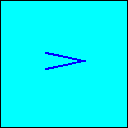 Accents are symbols placed on top or below one or
several notes. It tells you how the note should sound: Hard, soft, short, attacked,
hammered... Accents are often referred as articulation.
Accents are symbols placed on top or below one or
several notes. It tells you how the note should sound: Hard, soft, short, attacked,
hammered... Accents are often referred as articulation.
![]()
Articulation symbols indicate how a note should sound. Accents are one group of
articulation that indicates how hard, soft, short or long a note should sound. Other
articulation symbols indicates that a note should be repeated a number of times or should
express a certain texture.
 There are five basic accent symbols. Three of these
accents could be paired with the staccato. The staccato indicates that the note should be held for about half its
value. A series of staccato notes would sound as detached.
There are five basic accent symbols. Three of these
accents could be paired with the staccato. The staccato indicates that the note should be held for about half its
value. A series of staccato notes would sound as detached.
 The staccatissimo
indicates that the note should be held for a very short duration. The duration is about a
quarter of the note's normal value.
The staccatissimo
indicates that the note should be held for a very short duration. The duration is about a
quarter of the note's normal value.
 A tenuto
is a slight
accent that is held for the full duration of the note value. It gives an impression of a
heavy or weighted sound. Accents of this sort are often used to offset the natural accents
within a measure.
A tenuto
is a slight
accent that is held for the full duration of the note value. It gives an impression of a
heavy or weighted sound. Accents of this sort are often used to offset the natural accents
within a measure.
 The marcato is a strong
accent, somewhat forced, and usually struck hard. It is often used as a hard impact effect
resulting in a loud attack.
The marcato is a strong
accent, somewhat forced, and usually struck hard. It is often used as a hard impact effect
resulting in a loud attack.
 The martelato is a very
strong and heavy accent. It resembles a blow of a hammer. Such an accented note would
normally sound distorted and often used with string instruments.
The martelato is a very
strong and heavy accent. It resembles a blow of a hammer. Such an accented note would
normally sound distorted and often used with string instruments.
 A mezzo staccato is a
combination of the staccato and tenuto.
A note having this type of symbol would sound slightly accented and detached.
A mezzo staccato is a
combination of the staccato and tenuto.
A note having this type of symbol would sound slightly accented and detached.
 The staccato forzato is a
strong accent held for a short duration. It is a combination of the staccato
and the marcato.
The staccato forzato is a
strong accent held for a short duration. It is a combination of the staccato
and the marcato.
 The staccato duro is a
hard accent that may sound somewhat distorted yet for a short duration. It is a
combination of the staccato and the martelato.
The staccato duro is a
hard accent that may sound somewhat distorted yet for a short duration. It is a
combination of the staccato and the martelato.
 Articulations representing repeated notes are marked
with slashes. Slashes placed on the note stem. In the case of a whole note, the slash is
placed either above or below the note head following the same
rules as stem directions.
Articulations representing repeated notes are marked
with slashes. Slashes placed on the note stem. In the case of a whole note, the slash is
placed either above or below the note head following the same
rules as stem directions.
A note having one slash means that the note will be repeated in eighth notes for the duration of the note value.
A note having two slashes means that the note will be repeated in sixteenth notes for the duration of the note value.
A note having three slashes indicates that the note is an unmarked tremolo. The note is
repeated as many times as possible for the duration of the note.
 A note with four dots signify that the note is
divided in four notes of equal value. This type of symbol is placed on top of the note.
A note with four dots signify that the note is
divided in four notes of equal value. This type of symbol is placed on top of the note.
 Notes written as a beamed tremolo is an alternation
between two different notes. The notes are beamed with either one, two or three layers. It
follows the same rules as the slash where one beam is equivalent to one slash, two beams
equivalent to two slashes and so on. The note heads for these beamed notes are white.
Notes written as a beamed tremolo is an alternation
between two different notes. The notes are beamed with either one, two or three layers. It
follows the same rules as the slash where one beam is equivalent to one slash, two beams
equivalent to two slashes and so on. The note heads for these beamed notes are white.
 Notes with flags or beams can also be slashed. A
slash on a flagged note indicates that the duration of the note is shortened by half the
note value. Two slashes indicate that the flagged note is shortened by a quarter of the
note value.
Notes with flags or beams can also be slashed. A
slash on a flagged note indicates that the duration of the note is shortened by half the
note value. Two slashes indicate that the flagged note is shortened by a quarter of the
note value.